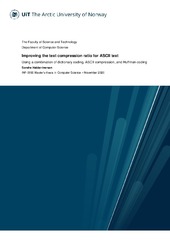WallMon : Interactive distributed monitoring of process-level resource usage on display and compute clusters
Permanent lenke
https://hdl.handle.net/10037/3991Åpne
Various resources, including videos of the system. (Ukjent)
Main article (PDF)
Dato
2011-11Type
Master thesisMastergradsoppgave
Forfatter
Nilsen, ArildSammendrag
To achieve low overhead, traditional cluster monitoring systems sample data at low frequencies and with coarse granularity. However, interactive monitoring requires frequent (up to 60 Hz) sampling of fine-grained data and visualization tools that can explore and display data in near real-time. This makes traditional cluster monitoring systems unsuited for interactive monitoring of distributed cluster applications, as they fail to capture short-duration events, making understanding the performance relationship between processes on the same or different nodes difficult. To address this issue, WallMon was developed, a tool for interactive visual exploration of performance behaviors in distributed systems. For gathering of data, WallMon is centered around an abstraction of collectors and handlers; collectors gathers data of interest, such as CPU and memory usage, and forwards it to handlers in a push-based fashion, while handlers take action upon the data. WallMon captures and visualizes data for every process on every node, as well as overall node statistics. Data is visualized using a technique inspired by the concept of information flocking. WallMon's design is based on the client-server model, and it is extensible through a module system that encapsulates functionality specific to monitoring (collectors) and visualization (handlers). A set of experiments have been carried out on a cluster of 29 nodes with 180 processes per node. Performance results show 7% (of 100) CPU usage at 64 Hz sampling rate when performing process-level monitoring with WallMon. Using WallMon's interactive visualization, we have observed interesting patterns in different parallel and distributed systems, such as unexpected ratio of user- and kernel-level execution among processes in a particular distributed system.
Forlag
Universitetet i TromsøUniversity of Tromsø
Metadata
Vis full innførselSamlinger
Copyright 2011 The Author(s)
Følgende lisensfil er knyttet til denne innførselen:
Med mindre det står noe annet, er denne innførselens lisens beskrevet som Attribution-NonCommercial-ShareAlike 3.0 Unported (CC BY-NC-SA 3.0)
Relaterte innførsler
Viser innførsler relatert til tittel, forfatter og emneord.
-
Improving the text compression ratio for ASCII text Using a combination of dictionary coding, ASCII compression, and Huffman coding
Haldar-Iversen, Sondre (Mastergradsoppgave; Master thesis, 2020-11-15)Data compression is a field that has been extensively researched. Many compression algorithms in use today have been around for several decades, like Huffman Coding and dictionary coding. These are general-purpose compression algorithms and can be used on anything from text data to images and video. There are, however, much fewer lossless algorithms that are customized for compressing certain types ... -
Beam based finite element modelling of Herøysund bridge
Berg, Patrick Norheim (Master thesis; Mastergradsoppgave, 2023-05-15)In this thesis the candidate aims to model two finite elements models of the post tensioned concrete Herøysund bridge. First a solid element model is modelled using the documentation from the bridge construction, then a beam element model is modelled using the solid model as a foundation. These models are subjected to a structural analysis that applies boundary conditions, joints, mass, gravity, ... -
Wireless charging of offshore wind service vessels
Nilsen, Henrik Fjeld (Master thesis; Mastergradsoppgave, 2021-05-18)This report discusses the possibility for wireless charging solutions for electric vessels, with a focus on offshore wind turbine service. Where the charging time is minimal and safety for crew is important. Different types of wireless technologies have been studied, where the Inductive power transfer (IPT) is shown to be the preferred technology. Inductive power transfer (IPT) grants a safe ...


 English
English norsk
norsk



